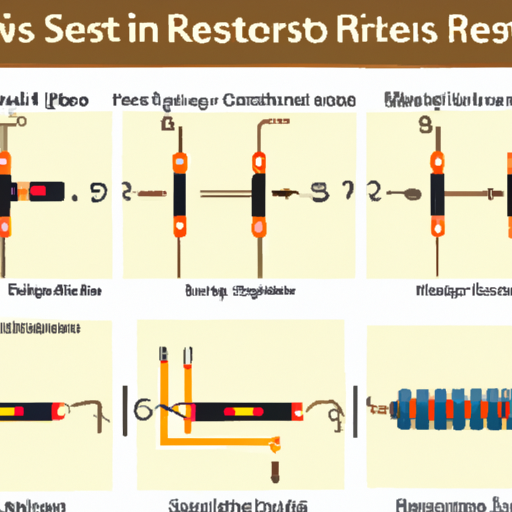What are the Top 10 Popular Resistor Connection Methods?
Introduction
Resistors are fundamental components in electronic circuits, serving the crucial role of controlling current flow and voltage levels. They are essential for protecting sensitive components, dividing voltages, and shaping signal characteristics. The way resistors are connected in a circuit can significantly impact the overall performance and functionality of the system. This article explores the top 10 popular resistor connection methods, providing insights into their definitions, characteristics, applications, and advantages.
1. Series Connection
A series connection involves linking resistors end-to-end, so the same current flows through each resistor. The total resistance in a series circuit is the sum of the individual resistances:
\[ R_{total} = R_1 + R_2 + R_3 + ... + R_n \]
Characteristics
Voltage: The total voltage across the series circuit is the sum of the voltages across each resistor.
Current: The current remains constant throughout the circuit.
Resistance: The total resistance increases with each additional resistor.
Applications and Advantages
Series connections are commonly used in applications where a specific voltage drop is required across each resistor, such as in LED circuits. They are simple to design and analyze, making them ideal for basic applications.
Example Circuit Diagram

2. Parallel Connection
In a parallel connection, resistors are connected across the same two points, providing multiple paths for current to flow. The total resistance in a parallel circuit can be calculated using the formula:
\[ \frac{1}{R_{total}} = \frac{1}{R_1} + \frac{1}{R_2} + \frac{1}{R_3} + ... + \frac{1}{R_n} \]
Characteristics
Voltage: The voltage across each resistor is the same.
Current: The total current is the sum of the currents through each resistor.
Resistance: The total resistance decreases as more resistors are added.
Applications and Advantages
Parallel connections are widely used in power distribution systems and in circuits where multiple components need to operate independently. They provide redundancy; if one resistor fails, the others can still function.
Example Circuit Diagram

3. Series-Parallel Connection
A series-parallel connection combines both series and parallel configurations, allowing for more complex circuit designs. This method is useful for achieving specific resistance values and voltage drops.
Characteristics
Voltage and Current: The characteristics depend on the arrangement of resistors in series and parallel.
Resistance: The total resistance can be calculated by analyzing the series and parallel sections separately.
Applications
Series-parallel connections are often used in audio systems and power supplies, where different components require different voltage levels and current ratings.
Example Circuit Diagram

4. Voltage Divider Configuration
The voltage divider configuration uses two resistors in series to create a specific output voltage that is a fraction of the input voltage. The output voltage can be calculated using the formula:
\[ V_{out} = V_{in} \times \frac{R_2}{R_1 + R_2} \]
Applications
Voltage dividers are commonly used in sensor circuits and signal processing applications, where a specific voltage level is needed for further processing.
Example Circuit Diagram

5. Current Divider Configuration
The current divider configuration is the opposite of the voltage divider, where resistors in parallel split the input current. The current through each resistor can be calculated using:
\[ I_n = I_{total} \times \frac{R_{total}}{R_n} \]
Applications
Current dividers are useful in current sensing applications and in circuits where current needs to be distributed among multiple paths.
Example Circuit Diagram

6. Pull-Up and Pull-Down Resistors
Pull-up and pull-down resistors are used in digital circuits to ensure stable logic levels. A pull-up resistor connects the input to a high voltage (usually Vcc), while a pull-down resistor connects it to ground.
Applications
These resistors are essential in microcontroller and logic circuit designs, preventing floating inputs that can lead to unpredictable behavior.
Example Circuit Diagram

7. Feedback Resistor Configuration
In operational amplifier (op-amp) circuits, feedback resistors are used to control the gain and stability of the amplifier. The gain can be set using the formula:
\[ Gain = 1 + \frac{R_f}{R_{in}} \]
Applications
Feedback resistor configurations are widely used in amplifiers and signal conditioning circuits, allowing for precise control over amplification.
Example Circuit Diagram

8. Resistor Networks
Resistor networks, or arrays, consist of multiple resistors connected in various configurations to achieve specific resistance values. They are often used for compact designs.
Applications
Resistor networks are commonly found in filters, signal processing, and in applications where space-saving designs are critical.
Example Circuit Diagram

9. Thermistor and Photoresistor Connections
Thermistors and photoresistors are types of variable resistors that change resistance based on temperature and light levels, respectively. They are often used in sensing applications.
Applications
These components are widely used in environmental monitoring, control systems, and in applications requiring temperature or light sensitivity.
Example Circuit Diagram

10. Resistor-Capacitor (RC) Circuits
RC circuits combine resistors and capacitors to create timing and filtering applications. The time constant (τ) of an RC circuit is given by:
\[ \tau = R \times C \]
Applications
RC circuits are used in oscillators, signal processing, and in applications requiring specific timing characteristics.
Example Circuit Diagram

Conclusion
Understanding the various resistor connection methods is essential for effective circuit design. Each method has its unique characteristics, advantages, and applications, making it crucial to select the appropriate configuration for specific needs. Whether designing simple circuits or complex systems, knowledge of these connection methods will enhance your ability to create efficient and functional electronic designs. We encourage further exploration and experimentation in circuit design to deepen your understanding and skills in this vital area of electronics.
References
- "The Art of Electronics" by Paul Horowitz and Winfield Hill
- "Electronic Principles" by Albert Malvino and David Bates
- Online resources and tutorials on circuit design and analysis.






